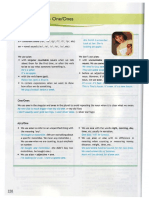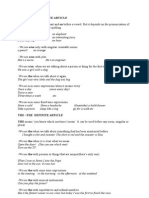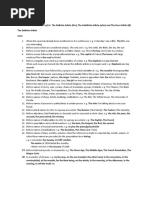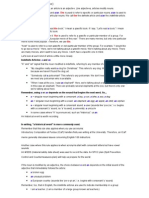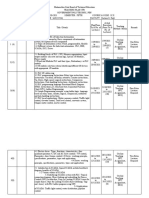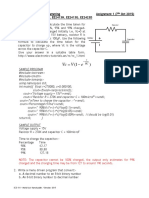0 ratings0% found this document useful (0 votes)
54 viewsA An Aeiou "H"
The document discusses the use of definite and indefinite articles (the, a, an) in English. It explains that "the" is used with specific nouns, superlatives, ordinal numbers, adjectives referring to a group of people, unique nouns, dates and times. It also notes that "a" is used with singular countable nouns starting with consonant sounds, while "an" is used with singular countable nouns starting with vowel sounds or silent h. The document provides examples to illustrate the rules for using articles.
Uploaded by
Patrycja BrengoszewskaCopyright
© © All Rights Reserved
We take content rights seriously. If you suspect this is your content, claim it here.
Available Formats
Download as PDF, TXT or read online on Scribd
0 ratings0% found this document useful (0 votes)
54 viewsA An Aeiou "H"
The document discusses the use of definite and indefinite articles (the, a, an) in English. It explains that "the" is used with specific nouns, superlatives, ordinal numbers, adjectives referring to a group of people, unique nouns, dates and times. It also notes that "a" is used with singular countable nouns starting with consonant sounds, while "an" is used with singular countable nouns starting with vowel sounds or silent h. The document provides examples to illustrate the rules for using articles.
Uploaded by
Patrycja BrengoszewskaCopyright
© © All Rights Reserved
We take content rights seriously. If you suspect this is your content, claim it here.
Available Formats
Download as PDF, TXT or read online on Scribd
You are on page 1/ 3
The - a definite article it is used
when you talk about specific
subject such as things, place or
person. (the sea, the universe)
The - is used before a
superlative.
(the smallest, the prettiest)
Miranda is the youngest in class.
The - is used before ordinal
numbers. 1. My father is _______________ engineer.
I am the first to complete the
2. _________ Japanese are known for their creativity.
quiz.
3. The Singapore Flyer is currently _______ tallest
The - is used with adjectives, to observational wheel (ferry wheel) in the world.
refer to a whole group of 4. __________ Statue of Liberty is in New York.
people. 5. I enjoyed ________ first part of “Harry Potter”.
The old folks need special 6. _________ Chinese has an ancient culture.
attention.
7. Mexico is one of _______ most populous cities in the
The - is used if it is the only world.
noun in the world. (the Great 8. My boss is ________ honest man.
Wall of China, the Eiffel Tower. 9. Ted is ________ skinniest boy in our class
10. _______ woodpecker is on the tree.
The - is used with dates, and 11. Mount Everest is ________ highest mountain.
some time expressions.
12. Don’t come near me, I have ______ bad flu.
Christmas is on the 25th
December. 13. My cousin has _______ Persian cat.
My mom goes to the 14. _______ Eiffel Tower is ______ tallest building in
supermarket in the afternoon. Paris.
15. _______ children are in the classroom.
16. I can play ________ tambourine.
17. In ______ sixties, the most popular hairstyle was a
beehive.
18. _______ Pope will visit the school next year.
19. My mother has been _______ gynecologist for ten
years.
20. We like to go to the park in ________ evening.
21. ________ mermaid is a mythological aquatic creature.
A is used with singular countable
nouns. (a moose, a picture)
An is used with singular countable
nouns that begin with the vowel
sound (a e i o u) or a silent “h”.
(an ugly picture, an honorable
person)
The - a definite article it is used
when you talk about specific
subject such as things, place or
person. (the sea, the universe)
The - is used before a
superlative.
(the smallest, the prettiest)
Miranda is the youngest in class.
The - is used before ordinal
numbers. 1. My father is _______________ engineer.
I am the first to complete the
2. _________ Japanese are known for their creativity.
quiz.
3. The Singapore Flyer is currently _______ tallest
The - is used with adjectives, to observational wheel (ferry wheel) in the world.
refer to a whole group of 4. __________ Statue of Liberty is in New York.
people. 5. I enjoyed ________ first part of “Harry Potter”.
The old folks need special 6. _________ Chinese has an ancient culture.
attention.
7. Mexico is one of _______ most populous cities in the
The - is used if it is the only world.
noun in the world. (the Great 8. My boss is ________ honest man.
Wall of China, the Eiffel Tower. 9. Ted is ________ skinniest boy in our class
10. _______ woodpecker is on the tree.
The - is used with dates, and 11. Mount Everest is ________ highest mountain.
some time expressions.
12. Don’t come near me, I have ______ bad flu.
Christmas is on the 25th
December. 13. My cousin has _______ Persian cat.
My mom goes to the 14. _______ Eiffel Tower is ______ tallest building in
supermarket in the afternoon. Paris.
15. _______ children are in the classroom.
16. I can play ________ tambourine.
17. In ______ sixties, the most popular hairstyle was a
beehive.
18. _______ Pope will visit the school next year.
19. My mother has been _______ gynecologist for ten
years.
20. We like to go to the park in ________ evening.
21. ________ mermaid is a mythological aquatic creature.
A is used with singular countable
nouns. (a moose, a picture)
An is used with singular countable
nouns that begin with the vowel
sound (a e i o u) or a silent “h”.
(an ugly picture, an honorable
person)
Answers
1. an 2. The 3. the 4. The 5. the 6. The 7. the
8. an 9. the 10. A/The 11. the 12. a 13. a 14. The/the
15. The 16. the 17. the 18. The 19. a 20. the 21. A
Picture Keys
3 10 8 20 12
16
18
15 14 19 21 4
11 17 9 13 5
You might also like
- the life of brunelleschi -- 10ba3cf84f8ffe3d68f473c1fc0a9268 -- Anna’s ArchiveNo ratings yetthe life of brunelleschi -- 10ba3cf84f8ffe3d68f473c1fc0a9268 -- Anna’s Archive200 pages
- English, Topic-Based Tests, Pre-Intermediate Level, Fluency PracticeFrom EverandEnglish, Topic-Based Tests, Pre-Intermediate Level, Fluency Practice3/5 (5)
- Definition: The Indefinite Article Is Just The Opposite of The Definite Article. in English, TheNo ratings yetDefinition: The Indefinite Article Is Just The Opposite of The Definite Article. in English, The8 pages
- A Course of English Grammar - Kechyan - ArticleNo ratings yetA Course of English Grammar - Kechyan - Article13 pages
- Evans Virginia Dooley Jenny Access 3 Grammar Book Plus-118-126No ratings yetEvans Virginia Dooley Jenny Access 3 Grammar Book Plus-118-1269 pages
- LECTURE ONE DEFINITE and INDEFINITE ARTICLESNo ratings yetLECTURE ONE DEFINITE and INDEFINITE ARTICLES12 pages
- Grammar: Definite Article and A/an The Indefinite ArticleNo ratings yetGrammar: Definite Article and A/an The Indefinite Article6 pages
- Articles, Rules of Usage PowerPoint ILI MD, E4 Grammar, Chapter 11No ratings yetArticles, Rules of Usage PowerPoint ILI MD, E4 Grammar, Chapter 1124 pages
- Articles: Do You Know Where Pyramids Are?No ratings yetArticles: Do You Know Where Pyramids Are?6 pages
- THE A / An: The Boy Loved The Girl's KindnessNo ratings yetTHE A / An: The Boy Loved The Girl's Kindness1 page
- Any Book Rather Than A Specific Book.: A/an A/an A/anNo ratings yetAny Book Rather Than A Specific Book.: A/an A/an A/an6 pages
- English, Topic-Based Tests, Elementary Level: English, Fluency Practice, Elementary Level, #3From EverandEnglish, Topic-Based Tests, Elementary Level: English, Fluency Practice, Elementary Level, #32.5/5 (5)
- Example Workbook ASAP Utilities FormulasNo ratings yetExample Workbook ASAP Utilities Formulas64 pages
- Political Caricature in Alfred Maccoy's Philippines Cartoons (Lacuenta, Jeana Karla L.)No ratings yetPolitical Caricature in Alfred Maccoy's Philippines Cartoons (Lacuenta, Jeana Karla L.)29 pages
- Handbook of Differential Equations Ordinary Differential Equations Volume 3 1st Edition A. Cañada All Chapters Instant Download100% (9)Handbook of Differential Equations Ordinary Differential Equations Volume 3 1st Edition A. Cañada All Chapters Instant Download60 pages
- Watching With The Simpsons Television Parody And Intertextuality Jonathan Gray instant downloadNo ratings yetWatching With The Simpsons Television Parody And Intertextuality Jonathan Gray instant download72 pages
- Appendix A - A Ā Ga Namaskāra: The Core Posture of Sūrya NamaskāraNo ratings yetAppendix A - A Ā Ga Namaskāra: The Core Posture of Sūrya Namaskāra5 pages
- In Language, The Ignorant Have Prescribed Laws To The LearnedNo ratings yetIn Language, The Ignorant Have Prescribed Laws To The Learned38 pages
- Presentation On Online Doctor Appointment System of A Multispeciality Hospital100% (2)Presentation On Online Doctor Appointment System of A Multispeciality Hospital55 pages
- Grammar: William Somerset Maugham, The Summing Up, 1938No ratings yetGrammar: William Somerset Maugham, The Summing Up, 19384 pages











